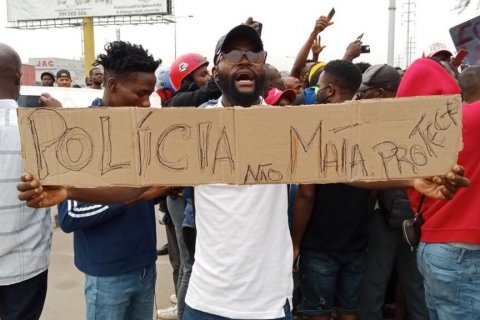It could, but it isn't. Instead of this almost idyllic landscape, mountains of garbage are visible, the smell of putrefaction, the metal shacks and the ubiquitous flies to afflict the former residents of Areia Branca, who settled there after being expelled from that island for an urban project that did not it happened.
Talita Miguel calls it the “June 1, 2013 massacre” and compares it to May 27, 1977, when an alleged coup by a dissident faction of the Popular Movement for the Liberation of Angola (MPLA) resulted in the deaths of thousands of people.
"We could decree the 1st of June 2013 as the day of the massacre of the children of Areia Branca", says the representative of the residents.
That morning, his neighborhood, located on the piece of land known as Ilha dos Pescadores, was invaded by the police and the army. Without notice, without dialogue with the population, the community that existed there 50 years ago saw their homes reduced to nothing after being razed to the ground by bulldozers.
"There were physical assaults, there was death, there were beatings, the children watched their parents being beaten", says Talita. The raid was the culmination of several days of siege, during which residents were deprived of food and water.
For Talita, the culprit of the conditions in which most of the 3000 displaced people currently live has a name: Isabel dos Santos.
According to the resident, the businesswoman dreamed of putting into practice an urban plan for that area, valued at around 600 million dollars, which was granted to her company, Urbinveste.
The story was just one more that emerged through the Luanda Leaks investigation, of the International Consortium of Investigative Journalists (ICIJ), which integrates Expresso and SIC. “The space belonged to Isabel dos Santos”, assures Talita Miguel, rejecting the denials of the businesswoman who denied on Twitter that the Marginal da Corimba project, implied the removal of people.
“It is a road over an embankment at sea, we have never displaced anyone. This project was neither paid nor built ”, denied the daughter of José Eduardo dos Santos.
"She, being human, mother, I believe she would not like to see her children in these conditions", commented Talita, adding: "There were deaths and there are still deaths because the place where we are is not a decent place, it is a place where there is no clean air, we breathe the impurities that come from the waste, from the pits ”, she denounces.
More than six years have passed, promises of resettlement have been many, but they stayed that way. Only a few of the 500 families managed to escape the fate that is now Pedro Alexandrino's reality. “Living here is difficult”, he says. Without basic sanitation or water or electricity supply, people crowd between two wastewater ditches that favor the onset of diseases such as typhoid, malaria or cholera.
“How are we going to live with the children with garbage next door? The situation is very critical here, ”said the resident in the barracas neighborhood.
Pedro Alexandrino, remembers the siege well: “Nothing could enter, neither water nor food, nobody could enter or leave”.
After riots and clashes lasting several days, the authorities finally opened the barriers. Then came the machines that “broke things,” the “trucks carrying people” that were then left on the road, without belongings or answers.
The community dispersed, but a large part ended up concentrating very close to the place where they were, next to the new Marginal, in one of the emblematic points of the city, the memorial erected in honor of the first president of Angola, Agostinho Neto.
The site that the inhabitants called “Povoado” has already been visited by deputies and ministers, but the problems remain unresolved.
While waiting for solutions, Pedro Alexandrino shows the heap made of sheets and demolition remains where he lives, along with other families. A “house” identical to the others in that neighborhood of narrow and labyrinthine alleys.
“This space is even bigger, compared to others of four square meters where seven families live”, he comments. “Why did we squeeze like that? Because there is little space. If we were to deploy, we would occupy more hectares because we are many. We build close to give to everyone ”, he says.
As for the island, it was deserted and remains so. “So far there is no project raised, we always see the island uncovered. There are simply two shipyards and we do not know what they are going to do there, we only know that the space has already been confiscated by the government, because there was a viaduct that would pass from here to Cuanza Sul, but only in 2019 did we hear that ”, explained Talita Miguel . “Before, we had heard that it would be buildings and that that area was privatized,” says Talita Miguel, felt it.
In May 2019, President João Lourenço annulled the global contract for the implementation of the Corimba marginal project, in the amount of 1300 million dollars, alleging that there were “over-invoicing in the values of the referred contracts, with costly services for the State”, which impose “manifestly disproportionate consideration in violation of the principles of morality, justice, transparency, economy and respect for public assets, underlying public procurement”. The director general of the company Urbinveste was Isabel dos Santos.







